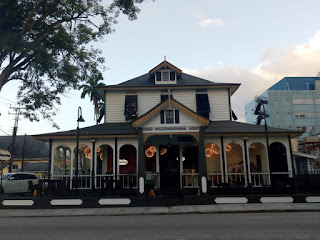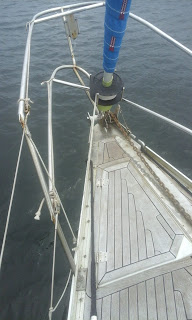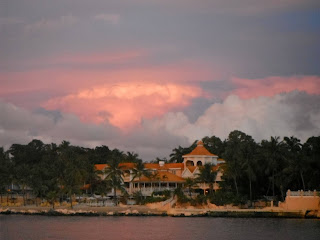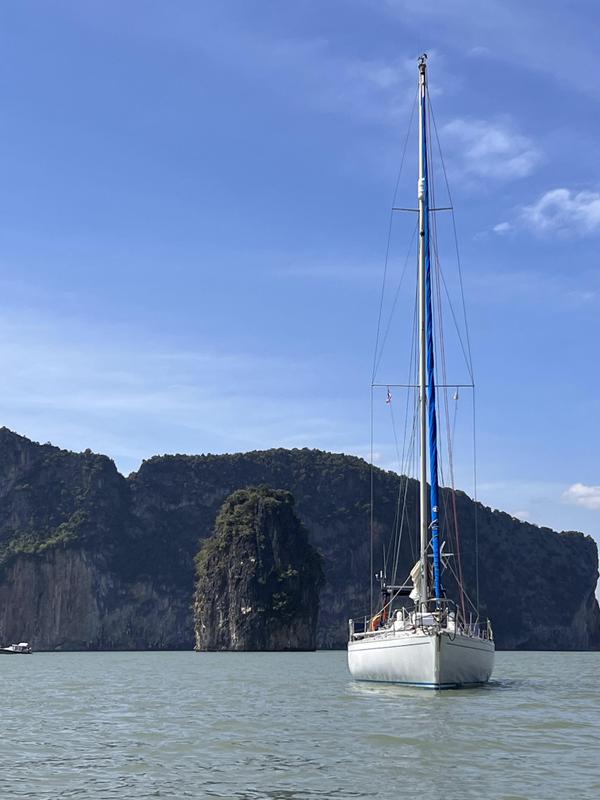 |
| Kurukulla at Coral Cove Marina |
The plan was to spend 5
months in and around Trinidad and Tobago during which Christoph (my
crew) and I would each spend a month back in Europe visiting friends
and family. He was to spend most of September back in UK/Switzerland
and I would take a month in UK/Europe in October/November.
Our choice of marina,
Coral Cove, in which we had decided to spend the hurricane season
was, a bit like the curates egg, good in parts! The pluses were that
it was relatively economic and well protected in the event of bad
weather. The downside was that it was getting run down with the
bathroom facilities being very basic, the “pool” only 5m by 4m,
and with no suitable swimming beach within walking distance. It is also troubled by local boats going in and out at full throttle with no thought for the wash they create and the potential for causing damage. One has to look macho!
 |
| Venezuelan fishing boats at Chaguaramas |
We were lucky to be
able to secure one of the best protected berths in the marina for the
whole period that we were there.
 |
| Local pirogues speeding through the marina area |
There was little difference in cost
between paying for the periods of time that we intended to spend in
the marina and paying for the entire period we were planning to be in
Trinidad; for security of supply we opted for the latter at a cost of
~£550 a month for a 39 ft mono-hull vessel.
Prior to Christoph's
departure for Europe, on 5 Sept, we spent many days out in the
islands to the west of Chaguaramas, at anchor. It was a much more
pleasant environment than cooped up in the marina with its booming
music and constant boat traffic. Our favourite was Chacachacare
Island, 7 miles west of Chaguaramas;
 |
| Doctors House at Chacachacare Island, Leper Colony |
it was, until the 1950's, the
site of the old leper colony. Many of the buildings remain although
the island is almost deserted, standfast a lighthouse keeper and
resupply visits by the T&T Coastguard. Most of the time is is an
oasis of peace and tranquillity compared with the almost incessant
loud music played in the more populated anchorages of Trinidad by
local boat owners. Trinnys' are wedded to deafeningly loud music
wherever they go! The only downside of Chacachacare is that it is
only 6 miles off the Venezuelan coast and therefore subject to a
somewhat higher piracy risk than the more populated islands nearer
Chaguaramas.
 |
| Swimming in the rain, Chacachacare |
That said we saw no evidence of piracy and the bay was
regularly patrolled by the T&T Coastguard.
 |
| Chacachacare in the rain |
Another unique feature
of our stay in Trinidad was experiencing the 25th August
earthquake; 6.8 on the Richter scale. We were berthed in the marina
and enjoying a mid afternoon cup of tea when we started to get the
sensation of a railway train going over multiple points.
 |
| Kurukulla anchored at Chacachacare |
We realised
this was not normal but it took a few seconds to appreciate that this
was an earthquake! Once on deck it was obvious, the jetties, built on
piles sunken into the harbour mud, were oscillating wildly moving
between 6 & 9 inches (15 – 22cm). My first reaction was to leap
for a knife to be ready to cut our lines if the jetties collapsed, I
was fearful the weigh might drag us under. Fortunately they survived
but with rather more cracks than previously, even more damage was
done in the area of the swimming pool where considerable movement was
evident through cracks in walls and the pool itself. A quick check
online with the US Earthquake Monitoring Service warned of a possible
tsunami in the Caribbean Sea but in the event this did not
materialise due to the depth below sea bed of the epicentre.
 |
| Earthquake damage to the Anglican Cathedral, Port of Spain. |
In any
case, where we were, we would have been protected from the worst
effects by the aforementioned islands.
Next day we were
scheduled to go into Port of Spain for a guided tour. At 0830 we
caught a maxi-taxi outside the marina for the 30 minute ride into the
city ($TT7 = £0.85 each). As we approached the city the local radio
announced that buildings in Port of Spain were being evacuated due to
an aftershock but we felt none of it, the joys of pneumatic tyres! We
were met by Jalaludin, a friend of a friend in UK, who is a local
historian and professional tour guide. He gave us a great one day
walking tour of the city, introducing us to much of its history and
many of the more modern achievements. An excellent day out! As part
of our tour we were also able to witness the damage to the Anglican
Cathedral which was one of the more seriously damaged buildings
during the previous day's earthquake.
 |
| Opera House, Port of Spain |
Many of the finials, gables and
much of the higher structure had collapsed or been rendered unstable.
It will be a long restoration project.
Following Christoph's
departure for UK I had a few days solo onboard. On one of these
nights, at 0230, I awoke to the sound of a loud splash and cries for
help. A fellow British yachtsman, returning onboard alone, had fallen
between the jetty and his yacht whilst trying to get back onboard. I
managed to haul him and his rucksack back onto the jetty, aided by a
French neighbour who by now had also been woken by the commotion;
sadly his livelihood, in the form of $1000s' (US) of photographic
equipment, had gone in the water with him in the rucksack and was in
all probability ruined.
 |
| One of the better preserved buildings in POS |
It was a tragedy averted in the sense of no
loss of life but not in the sense of loss of livelihood! Thank
goodness he didn't hit his head on the way in; if he had I might not
have heard him. Moral of the tale be exceedingly cautious when
yachting alone, especially when "having drink taken!" On a
lighter note, in this period I also took delivery of a brand new No1
genoa from Ullman Sails, the old No1 sail was getting too fragile to
bother repairing it any more. It still showed evidence of the sail
number from Kurukulla's original Italian registration so it had given
at least 20 years of good service and probably more!
Next to arrive onboard
was a Greek friend, Yorgos, who was to keep me company for the next
month. The plan, once the bureaucracy of getting Christoph off the
crew list and Yorgos on to it had been achieved with the Immigration
and Customs authorities, was to head back to Tobago and enjoy the
bays and more tranquil surroundings of Tobago for the majority of
Yorgos's visit.
 |
| Waterfalls at La Vache after torrential downpour |
During our second visit to Customs and Immigration,
this time to obtain clearance to leave Trinidad for Tobago; it was us
who had to explain to the Immigration Staff that we did not require
exit stamps in our passports as we were not leaving the country
(Trinidad & Tobago); after some debate the stamps were duly
crossed through and cancelled. You might think Immigration staff
would know the composition of their own country! That problem
resolved we set off spending nights at anchor in Chacachacare Island,
Monos Island, La Vache Bay, Chupara Bay and finally Grande Riviere
Bay before crossing to Tobago. Whilst anchored in La Vache we endured
an absolutely torrential rain storm resulting in the waters of the
bay becoming dark brown with the silt washed off the land but more
spectacularly seven or more amazing waterfalls sprang up out of
nowhere discharging the run off into the bay, beautiful.
 |
| Sunset at Pigeon Point anchorage |
From Grande Riviere Bay
we set off early for Tobago where we would again be required to
report our arrival to the Customs and Immigration offices, in
Scarborough, (The anchorage at Scarborough is all but untenable for
small vessels). Arriving out of working hours incurs overtime
payments for these “services” and hence, it being 1700 already,
we decided to anchor inside the coral reef off Pigeon Point, a
picturesque and well known anchorage, and report ourselves as having
arrived in the morning of the following day. At 2000 I was down below
preparing supper whilst Yorgos was in the cockpit reading by the
light of the table lamp.
 |
| Not quite the shape it was! |
We both heard a boat fast approaching and I
assumed it was a fisherman in a fibreglass “pirogue” (local fast
small boats used for fishing) passing close, as is their custom. The
problem was that this guy hadn't seen us despite anchor light, cabin
lights and the table light on deck! He struck our bow hard but
fortunately the pulpit and anchor launch arrangement took the
majority of the blow, he missed taking out the forestay and brand new
genoa by a hair's breadth; a few feet to the left and he might well
have holed us sufficiently to send Kurukulla to the bottom!
 |
| Store Bay Resort, we anchored just off. |
Having picked himself
up off the deck and retaken control of the boat he came back and we
took him alongside. As you can imagine Yorgos was more than somewhat
shaken, and I was not best pleased! My humour deteriorated further on
discovering that he was not insured! That said he was almost
overwhelmingly apologetic and patently a decent person who freely
admitted it was his fault. On inspecting the damage to Kurukulla it
was a obvious the pulpit was a write off and there was very slight
distortion of the anchor launch fitting (not affecting appearance or
operation).
 |
| Yorgos at Mount Irvine Bay |
My guess was that the cost of repair was going to be in
the region of £1000 to have a new pulpit fabricated; what I could
recover from him was going to be limited by his ability to pay. In
the end we agreed on a sum of $TT6000 which equated to £680 and
which he agreed to produce in cash the following morning, as soon as
the banks opened. For my part I agreed not to make any further claim
and not to inform the Coastguard. At that point he went on his way.
Good to his word, the
following morning at 0940 I received a telephone call from him
hastening me to come ashore and receive the money as he was nervous
about hanging around with so much cash on him. If I am honest I felt
sorry for him; I too have had one close call when single handed, at
night, in my case in fog, and if things had been different I would
have been liable. As it was he was a thoroughly nice guy and on
return to Chaguaramas, based on my description of the circumstances
surrounding the damage to the pulpit, I was able to negotiate its
replacement with Mitchell, South West Fabricators, at a discounted
price, just under the £1000 estimate I first made. No one hurt and
no permanent harm done...
 |
| Castara Bay, Boathouse Restaurantjust left of centre |
After the trauma of the
first night we moved early next morning into the protection of Store
Bay to meet our man and later to set off by maxi-taxi for the 7 miles
to Scarborough to get through the bureaucracy of arrival in Tobago.
Three hours later we were back onboard and, after a second night at
anchor, this time in Store Bay, we set off up the coast to visit all
the bays I had covered when en route to Trinidad a month or so back.
 |
| Englishman's Bay |
Ten days later we were in Charlotteville (yet another pair of hours
wrestling with Immigration and Customs bureaucracy) and we then spent
the next two weeks slowly trickling back down the coast to Store Bay.
The favourite bay by far on this stretch was Castara where we
lingered for four days.
 |
| Sunset at Englishman's Bay |
During our visit we got to know the owners of
the very welcoming Boathouse Restaurant (Brenton and Sharon Taylor)
at the far NW end of the beach, in front of which operated a few
local fishermen/divers with their Pirogues. One in particular had
problems with an engine he had just purchased second hand (250HP on a
20ft open boat!) and the engineer duly attended replacing a defective
spark plug. Success the boat was able to fly! Next day we witnessed
the remains of the boat and engine pulled up on the beach, both
severely damaged and undoubtedly beyond repair. The owner plus one
had gone out fishing the previous evening and managed to turn the
boat over on the coral reef just outside the bay.
 |
| View from Boathouse Restaurant and the boat that was destroyed. |
Both had managed to
get ashore but had been badly injured by the swell; the crew was
still in hospital, and the owner extensively bandaged. What remained
of the boat and its engine had been salvaged the following morning.
Moral; open boats and excessively large outboard motors can be a
lethal combination in a variety of circumstances!
Our departure plan was
to check out from Tobago on the Saturday morning and spend the next
three days cruising back to Chaguaramas, Trinidad. This was not to
be. After getting a taxi from Store Bay to Scarborough we discovered
that although the Customs offices were manned the Immigration Office
was not. Closed until Monday! My mistake, I should have checked!
 |
| Charlotteville waterfront |
We
returned to Store Bay, treated ourselves to lunch ashore and settled
down for the weekend intending an early start on Monday. Annoyingly
the Tobago International airport is at Store Bay but they they
absolutely refuse to clear yachts there, despite a 24 hour Customs
and Immigration presence.
Monday morning arrived
and we were at the Immigration offices in Scarborough at 0820 in the
morning; hoping to make our escape from Tobago by 1100 latest as this
was the deadline for a daylight arrival in Trinidad. Only one boat
crew in the queue in front of us …. but …. they had departed
Trinidad intending to go to Grenada but then diverted to Tobago
because of autopilot problems
 |
| Sunset at Store Bay |
(obviously couldn't sail without it!).
This created a crisis that took nearly 2 hours to resolve. Should
their departure papers from Trinidad be cancelled or should they be
re admitted to Trinidad and Tobago at Scarborough? This took endless
phone calls and much heated discussion to resolve and “No, it is
not possible to deal with more than one boat at a time!”. Having
eventually dealt with Immigration, a process that took precisely 7
minutes once we were served, we moved on to Customs. It was
eventually 1130 when we exited the Customs office and too late to
depart Tobago that day and arrive in daylight in Trinidad.
 |
| Our accompanying dolphins |
We
resigned ourselves to another night in Store Bay and eventually set
off at 0400 the next morning direct to Scotland Bay, only 3 miles
from Chaguaramas;
 |
| Scotland Bay in the early morning |
we arrived just before sunset. The greatest joy of
the passage was being accompanied, for nearly an hour, by the largest
pod of dolphins seen since we left the Mediterranean.
Next morning,
Wednesday, we again set off relatively early in order to get in to
Chaguaramas, report our arrival to Immigration and Customs (you get
to know them well if you decide to cruise in these waters!) and go to
collect a hire car ready to meet Christoph, at the airport; he was
returning that evening. That done we relaxed for the rest of the day!
 |
| Self at Macqueripe Bay |
 |
| La Vache Bay from above |
Our plan was to use the hire car over the next six days to tour
Trinidad and get to see some of the interior. This we did visiting
the town of San Fernando (the second town of Trinidad); the world's
largest bitumen lake; and touring the beaches of the north coast by
car to get a different perspective.
 |
| The worlds largest pitch lake |
The days passed all too
quickly and by the following Wednesday, early morning, Yorgos and I
were boarding a plane for UK for me to spend a month back in Europe
and for him to return to Paros in Greece, his home.
 |
| and suprising vegetation. In a pitch lake! |
En route we had a
ten hour stopover in Antigua and I took the opportunity to show
Yorgos some of the island sights, Jolly Harbour, English Harbour and
Nelson's Dockyard etc. I was amazed to find out that Jolly Harbour
was closing for 3 months and Nelson's Dockyard was astoundingly
empty!
Hurricane season or not it seemed eerily quiet!
My month in Europe
disappeared in a flash and within no time I found myself again
boarding a Virgin transatlantic flight, this time to return to
Trinidad.
 |
| Yorgos at Nelson's Dockyard, Antigua |
Two weeks of maintenance, the fitting of the newly
fabricated pulpit and a final visit out to Chacachacare then we are
off again destination the ABC Islands (Aruba, Bonaire and Curacao)
for Christmas, via the Saint Vincent Grenadines to avoid following
the Venezuelan coastline too closely . More when we arrive....
 |
| Nelson's Dockyard, English Harbour, Antigua - Totally empty! |
 |
| The new pulpit! |
